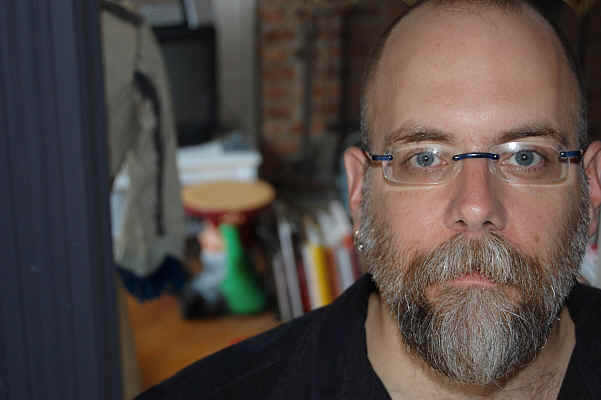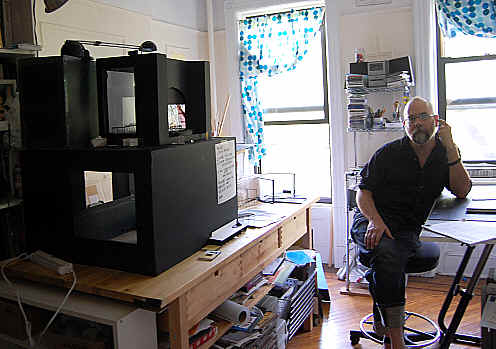|

“I use the word clunky a lot to describe what interests me,” says designer David Zinn. “A big ugly shape, kind of finessed, thick but also very sensual and beautiful – if there’s a way to get all that in, that’s become my agenda for both scenery and costumes.”
That beautiful clunkiness has propelled Zinn into the ranks of theater’s most in-demand designers. Last year, just before he turned 40, he received an Obie Award for sustained achievement that cited three productions for which he’d designed sets: the candy-colored nightmare that was Daniel Fish’s staging of Chuck Mee’s
Paradise Park at Signature Theater; Itamar Moses’s intimate, austere
The Four of Us at Manhattan Theatre Club; and the multilayered parlor of imagination in which Elevator Repair Service inhabited Faulkner’s
The Sound and the Fury, which premiered at New York Theater Workshop and then toured internationally. Meanwhile, two musicals for which he designed costumes overlapped on Broadway, the deliriously pop-campy
Xanadu and Jill Santoriello’s adaptation of Dickens’s 18th-century saga
A Tale of Two Cities.
“I’m of a generation who discovered we were equally musical-theater nerds and Wooster Group devotees,” says Zinn, who moved from Seattle in 1987 to study design at New York University with Oliver Smith and John Conklin and spent much of his spare time doing AIDS activism with ACT UP. This generational cohort decisively abandons notions of pure theater for aggressive postmodernism’s sheer pleasure in mashing things together.
“Every time I hear the words ‘timeless’ and ‘empty space’ I want to kill myself,” Zinn wrote in a statement for the 2007 Prague Quadriennial (“essentially an international
Star Trek convention for theater designers,” he jokes). “In design, I try to set up the ideal, and then desecrate it. Make the perfect room and then scribble in the corner. Make the perfect dress, and then try to clean a toilet in it.”
Today, on a rainy Monday in early June, Zinn is taking a momentary breather from the frequent-flyer circuit that is home for most designers. He’s just finished designing Mozart’s
Il Re Pastore at Opera Theatre of St. Louis, directed by his frequent collaborator Chas Rader-Shieber, and costumes for Rajiv Joseph’s
Bengal Tiger at Baghdad Zoo at the Mark Taper Forum, staged by Moises Kaufman (a former NYU classmate). Now he’s gearing up to do clothes for Annie Baker’s
Circle Mirror Transformation, opening in September at Playwrights Horizons, and Les Waters’s production of Sarah Ruhl’s
in the next room, or The Vibrator Play, which played at the Berkley Repertory Theatre last winter and moves to Lincoln Center Theater in November.
For all his have-portfolio-will-travel flexibility, Zinn cultivates an encyclopedic visual vocabulary that rarely rests in theater. Although he is known in some quarters for his ability to render exquisite 18th-century costumes, formative aesthetic influences also range from the extreme performance style of Kiki and Herb’s Justin Bond to the 1993 Whitney Biennial, with its controversial focus on identity politics and issues of representation. As a baby designer, “I was a big fashion addict,” says Zinn, a bearishly handsome guy with a bushy salt-and-pepper beard and tribal tattoos snaking down his arm. “I was interested in Martin Margiela, and Comme des Garcons, Dries van Noten, early Helmut Lang. I was excited by this mix of cross-period beauty and a deconstructive impulse, applying an intellectual logic to the structure of clothing to make a new shape.
“When I think about the spaces that have become interesting to me, it’s the same idea,” he continues. “There’s a photographer named Lynn Cohen who shoots all these empty-of-people industrial or middle-management places of instruction. When I first saw her photos, I was completely taken by her suggestive use of these clunky dead spaces. Like the place where you rent your car at the airport – you know, badly designed, a little too low, ominous, not very welcoming, attempting to be neutral. I like taking those spaces and colliding something up against them. Making something more magical than what was slated to happen in that room, happen in that room.”
Many designers individuate as artists through close, continuing collaborations with simpatico yet challenging directorial minds. For Zinn, an early partnership with Target Margin’s David Herskovits (another NYU classmate) allowed him to incubate his excitable visual sensibility. “David’s responsiveness to my own quirky taste is profound. He understands me in a pre-verbal way,” Herskovits says of Zinn. “He seeks the beauty in what is ordinary, drab, and even ugly. He is unafraid to mark, scar, obscure or veil what is easy, believing as I do that the resistance we as audience must face ultimately will enable a more true (and therefore more beautiful) experience.”

In recent years Zinn has expanded the edges of his creativity in cahoots with the legendary director Robert Woodruff. On the drawing board at his home studio in Brooklyn
(above) are sketches for Zhou Long’s
Madame White Snake, which Woodruff will direct for Opera Boston next February. Since they met in 2000, during Woodruff’s tenure as artistic director of the American Repertory Theatre at Harvard, their working relationship has been a challenging and liberating testing ground for Zinn.
“The first project we did together, Rinde Eckert’s Highway
Ulysses, was a big exercise in profound frustration for both of us,” Zinn recalls. “I spent a lot of time trying to figure out what he wanted from me and delivering that. He could sense that what I was giving him wasn’t strong enough to respond to. I was afraid to give him something so strong. I didn’t know I could give him that. I was too willing to change what I was presenting him based on his response. It was destabilizing for him. It felt like quicksand. It was an incredible lesson about standing up for yourself. Making choices you believe in and standing behind them. Not being inflexible, but taking the step you think you need to take, regardless of whether you’ve been given permission.”
After four productions at the ART (culminating in an outrageous 2005 rendering of Marivaux’s
Island of Slaves) and Edward Bond’s Chair last season for Theater for a New Audience, no trace of tentativeness remained when Zinn and Woodruff teamed up with actor Bill Camp at Yale Repertory Theatre last spring on an adaptation of Dostoevsky’s
Notes from Underground. The production radiated an extremely free, European-style theatricality in its interplay of performance, design, music, video, and staging.
The audience entering discovered onstage a derelict office space with some funky furniture and punched-out walls, snow falling through one patch of ceiling, and every surface covered with about an inch of snow: already a potent image drenched in sadness and mystery.
“David brings great mythical ideas to earth but retains a poetry in space,” Woodruff says. “Live bodies scrape against his work creating friction in the best sense. Notes started with an image of mine, a single monolithic wall, which in the end had none of the above-mentioned friction and so it was abandoned. The idea of an office, an abandoned milieu from a defunct start-up perhaps where Bill’s character had encamped, combined with a studio for the performance of
Notes, was the next emerging metaphor which took hold. The idea of the space being buried under snow defined both Russia and his plight and gave the piece an abstractness which just left its architectural frame without much detail.”
“When I met Woodruff,” says Zinn, “he’d worked with the great designers of our time – Bob Israel, George Tsypin. George would make these incredible machines that are aggressive and take over the stage. I don’t do that. Bob would make these powerful period-echoing rooms that collapsed on themselves. That’s thrilling, and it’s not something I do. The crap-in-a-room world that became
Notes from Underground was something I brought to him later. Our first collaborations were more collagey, scaffoldy, nothing in the theater except a bunch of crap in the middle and some Plexiglas.” He pauses, smiling fondly, visions of clunkiness dancing in his head. “It was awesome.”
American Theatre, October 2009
|